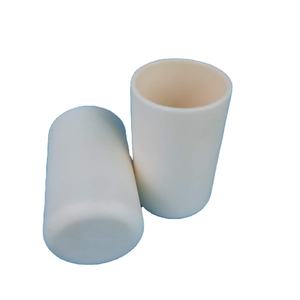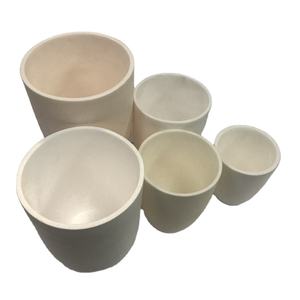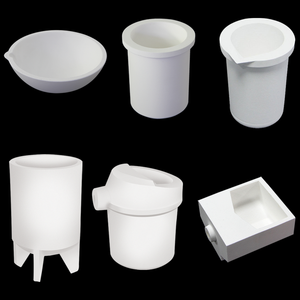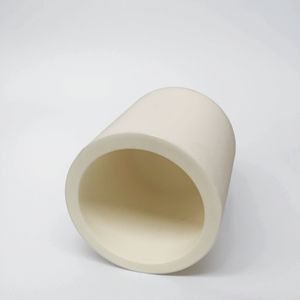Professional industry ceramic supplier, silicon nitride, silicon carbide, aluminum nitride and any other kinds of ceramics.
PRODUCT PARAMETERS
Description
Overview of Dental Laboratory Hooded Casting Quartz Ceramic Crucible
Dental Laboratory Hooded Casting Quartz Ceramic Crucible are specialized containers designed for withstanding extremely high temperatures in laboratory and industrial settings. They are essential for processes such as melting, calcining, and heat-treating a wide variety of materials, including metals, glasses, and chemicals. Our crucibles are engineered for superior thermal stability and chemical resistance, ensuring purity and reliability in the most demanding applications.
Features of Dental Laboratory Hooded Casting Quartz Ceramic Crucible
-
Exceptional Thermal Shock Resistance: Withstands rapid temperature changes without cracking, ensuring durability and a long service life.
-
High-Temperature Stability: Maintains structural integrity at extreme temperatures, often exceeding 1500°C.
-
Excellent Chemical Inertness: Resists corrosion and reaction with molten metals, acids, and aggressive chemical fluxes.
-
High Purity & Low Contamination: Manufactured from premium materials to prevent sample contamination during sensitive processes.
-
Optimized Thermal Properties: Designed for efficient heat transfer and consistent performance in furnace environments.
-
Robust Mechanical Strength: Offers good resistance to physical impact and abrasion during handling and use.
Specifications of Dental Laboratory Hooded Casting Quartz Ceramic Crucible
Here are the specifications for our Dental Laboratory Hooded Casting Quartz Ceramic Crucible. This crucible is made from high-purity fused quartz ceramic. The material offers exceptional heat resistance. It withstands temperatures up to 1700°C (3092°F). This high melting point is essential for dental alloy casting. The crucible features a unique hooded design. The hood helps contain molten metal. It directs the flow precisely during casting. This minimizes spills and improves safety. The hood also reduces oxidation of precious alloys. Oxidation can ruin the casting result.
The crucible provides excellent thermal shock resistance. It handles rapid heating and cooling cycles well. Sudden temperature changes won’t cause cracking. This ensures reliability during repeated use. The inner surface is very smooth. It has a non-wetting property. Molten alloys don’t stick to it. Cleanup is easier. Material waste is reduced. The crucible offers high chemical stability. It resists corrosion from aggressive fluxes and alloys. This prevents contamination of your castings. Purity is maintained throughout the process.
Standard sizes are available. Common inner diameters range from 15mm to 30mm. Heights vary from 20mm to 45mm. The hood adds extra protection. The design ensures stable placement on casting machines. Stability is crucial for precise pouring. The crucible delivers consistent thermal performance. Heat distribution is uniform. This is vital for achieving accurate alloy melting. The fused quartz ceramic is naturally inert. It won’t react with your dental metals. Crucible integrity lasts longer. You get more casts per crucible.
Applications of Dental Laboratory Hooded Casting Quartz Ceramic Crucible
Dental labs need reliable tools for melting metal. Hooded casting crucibles made from quartz ceramic are essential. These crucibles hold molten metal during the casting process. They are specifically designed for dental applications like crowns, bridges, and partial dentures. The quartz ceramic material is key. It handles extremely high temperatures very well. Dental alloys melt at these high heats. Quartz ceramic resists thermal shock. Sudden temperature changes won’t crack it easily. This durability means the crucible lasts longer. It saves labs money over time.
The integrated hood is a major advantage. It fits tightly over the crucible top. This hood traps heat inside the chamber. Melting happens much faster. Less energy is needed. The hood also protects the molten metal. It stops airborne dust and debris from falling in. Contamination ruins a casting. Clean metal is vital for strong, defect-free dental restorations. Workers are safer too. The hood reduces splashing and spitting of hot metal.
Dental technicians use these crucibles daily. They work with many alloy types. Gold alloys, cobalt-chrome, nickel-chrome, and semi-precious metals are common. The quartz ceramic material works for all these. It doesn’t react with the molten metal. This keeps the alloy pure. Consistent results are easier to achieve. The crucible fits standard casting machines. Setting it up is straightforward. Cleaning after use is simple. Proper care extends its life further.
Company Profile
Tanki New Materials Co.Ltd. focus on the research and development, production and sales of ceramic products, serving the electronics, ceramics, chemical and other industries. Since its establishment in 2015, the company has been committed to providing customers with the best products and services, and has become a leader in the industry through continuous technological innovation and strict quality management.
Our products includes but not limited to Aerogel, Aluminum Nitride, Aluminum Oxide, Boron Carbide, Boron Nitride, Ceramic Crucible, Ceramic Fiber, Quartz Product, Refractory Material, Silicon Carbide, Silicon Nitride, ect. please feel free to contact us.

Payment Methods
T/T, Western Union, Paypal, Credit Card etc.
Shipment Methods
By air, by sea, by express, as customers request.
5 FAQs of Dental Laboratory Hooded Casting Quartz Ceramic Crucible
What material is this crucible made from?
This crucible uses pure quartz ceramic. Quartz ceramic handles extreme heat well. It resists cracking under sudden temperature changes. This material also fights chemical reactions with metals. Your alloys stay pure during melting.
Why does it have a hood?
The hood traps heat inside the crucible. This makes melting metal faster. It also saves energy. The hood stops metal from splashing out. This protects you and your equipment. It keeps the casting process cleaner and safer.
How hot can it get?
This crucible handles very high temperatures. It works fine up to 1300°C (2372°F). This covers most dental alloy melting points. It won’t warp or break down at normal casting heats. You can trust it for consistent results.
Can I use it more than once?
Yes, you can reuse this crucible. Quartz ceramic is tough. It resists wear from repeated heating and cooling. Check it carefully before each use. Look for cracks or heavy damage. Stop using it if you see any flaws. A damaged crucible risks failure.
How do I clean it?
Cleaning is simple after the crucible cools down. Knock out leftover metal carefully. Use a soft brush or cloth to remove debris. Avoid harsh chemicals or abrasive tools. They can damage the ceramic surface. Rinse with water if needed. Make sure it’s completely dry before storing it.
REQUEST A QUOTE
RELATED PRODUCTS

Laboratory High Temperature Ceramic Oven Dental Ceramic Crucible

Stackable Cordierite Mullite Ceramic Sagger Crucible and Saggar for Sintering

High Quality Silicon Carbide Graphite Crucible 250kg 350kg Refractory Sic Ceramic Crucible for Glass Melting

High Purity or Conical Alumina Ceramic Crucible for Metal Smelting

Ceramic Melting Casting Crucible Smelting Gold Platinum Silver Metal and Glass Fused Silica Heating Cup Bowl Pot Quartz Crucible



